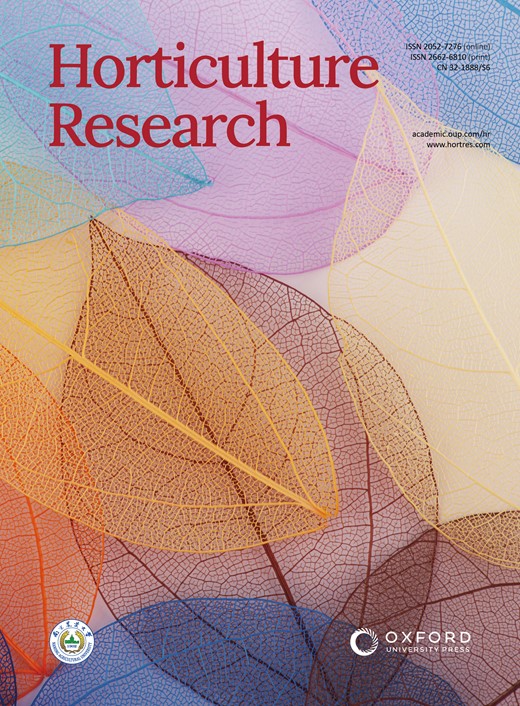叶绿体蛋白 StFC-II 受一种 Phytophthora 效应子的操纵,可提高宿主的易感性
IF 8.7
1区 农林科学
Q1 Agricultural and Biological Sciences
引用次数: 0
摘要
卵菌向宿主细胞分泌一系列 RxLR 效应子,通过靶向多个细胞器的蛋白质来操纵植物免疫。在本研究中,我们报告了叶绿体蛋白 StFC-II 被病原体效应物劫持以增强易感性。根瘤蚜 RxLR效应子 Pi22922 在根瘤蚜定植的早期阶段被激活。在植物中稳定过表达 Pi22922 可抑制 flg22 触发的活性氧(ROS)爆发,并增强 P. infestans 在叶片上的定殖。马铃薯铁螯合酶 2(FC-II,一种核编码的叶绿体靶向蛋白)是叶绿体中血红素生物合成的关键酶,被鉴定为 Pi22922 在细胞质中的靶标。Pi22922 对植物的致病性部分依赖于 FC-II。过量表达 StFC-II 会降低马铃薯和烟草对 P. infestans 的抗性,而在 N. benthamiana 中沉默 NbFC-II 会减少 P. infestans 的定殖。过表达 StFC-II 会增加马铃薯叶片中的血红素含量,降低叶绿素含量和光合效率。此外,在 StFC-II 过表达转基因马铃薯和 N. benthamiana 叶片中,叶绿体和细胞质中的 ROS 积累均减弱,防御相关基因下调。Pi22922 可抑制 E3 泛素连接酶 StCHIP 介导的 StFC-II 在细胞质中的降解,并促进其在叶绿体中的积累。总之,本研究揭示了一种新的机制,即一种卵菌 RxLR 效应子通过促进 StFC-II 在叶绿体中的积累来抑制宿主的防御能力,从而损害宿主的免疫力并促进易感性。本文章由计算机程序翻译,如有差异,请以英文原文为准。
Chloroplast protein StFC-II was manipulated by a Phytophthora effector to enhance host susceptibility
Oomycete secretes a range of RxLR effectors into host cells to manipulate plant immunity by targeting proteins from several organelles. In this study, we report that chloroplast protein StFC-II is hijacked by a pathogen effector to enhance susceptibility. Phytophthora infestans RxLR effector Pi22922 is activated during the early stages of P. infestans colonization. Stable overexpression of Pi22922 in plants suppresses flg22-triggered reactive oxygen species (ROS) burst and enhances leaf colonization by P. infestans. A potato ferrochelatase 2 (FC-II, a nuclear-encoded chloroplast-targeted protein), a key enzyme for heme biosynthesis in chloroplast, was identified as a target of Pi22922 in the cytoplasm. The pathogenicity of Pi22922 in plants is partially dependent on FC-II. Overexpression of StFC-II decreased resistance of potato and Nicotiana benthamiana against P. infestans, and silencing of NbFC-II in N. benthamiana reduces P. infestans colonization. Overexpression of StFC-II increases heme content and reduces chlorophyll content and photosynthetic efficiency in potato leaves. Moreover, ROS accumulation both in chloroplast and cytoplasm were attenuated and defense-related genes were down-regulated in StFC-II overexpression transgenic potato and N. benthamiana leaves. Pi22922 inhibits E3 ubiquitin ligase StCHIP-mediated StFC-II degradation in the cytoplasm and promotes its accumulation in chloroplasts. In summary, this study characterizes a new mechanism that an oomycete RxLR effector suppresses host defenses by promoting StFC-II accumulation in chloroplasts, thereby compromising the host immunity and promoting susceptibility.
求助全文
通过发布文献求助,成功后即可免费获取论文全文。
去求助
来源期刊

Horticulture Research
Biochemistry, Genetics and Molecular Biology-Biochemistry
CiteScore
11.20
自引率
6.90%
发文量
367
审稿时长
20 weeks
期刊介绍:
Horticulture Research, an open access journal affiliated with Nanjing Agricultural University, has achieved the prestigious ranking of number one in the Horticulture category of the Journal Citation Reports ™ from Clarivate, 2022. As a leading publication in the field, the journal is dedicated to disseminating original research articles, comprehensive reviews, insightful perspectives, thought-provoking comments, and valuable correspondence articles and letters to the editor. Its scope encompasses all vital aspects of horticultural plants and disciplines, such as biotechnology, breeding, cellular and molecular biology, evolution, genetics, inter-species interactions, physiology, and the origination and domestication of crops.
 求助内容:
求助内容: 应助结果提醒方式:
应助结果提醒方式:


